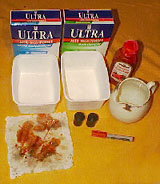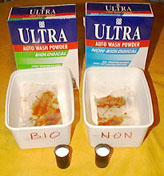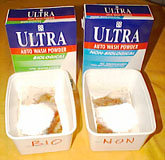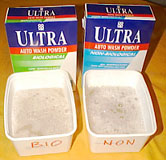




Background
Information and References
One of the greatest developments in hygiene within the last
few decades has been the invention of enzyme washing powders. These
work by "eating" dirt in the same way that your digestive system might
break-down food. This digestive action is achieved in the same way
- by using enzymes. The enzymes
in washing powder are produced by micro-organisms.
By 2020 on the Space Station, it is likely that enzyme reactions such as is used by your washing powder will be used to breakdown all types of waste products - as well as being used simply as a washing compound. It is also likely that one or more bio-reactors, containing the necessary types of enzyme-producing micro-organism, will be available. In this way astronauts will be able to manufacture their own "designer" enzymes for specific tasks, from waste matter. Once again making use of a recycling system that will assist in making the Space Station self-sufficient.
Bernard Dixon's book Power Unseen - How microbes rule the World has an excellent brief account of the development of enzyme washing powders.

Investigation: Does enzyme washing powder really produce better results?Test this out under laboratory conditions!
Materials
and equipment:
You need:
A
piece of clean white cloth
A few grams (ounces) of soap powder
The same amount of enzyme washing powder
Some ketchup
A marker pen
Warm water
Two ice cream tubs<
A thermometer (standard "freezing to boiling" type is fine)
This is optional

Procedure:
- Take the clean cloth and mark it with the marker pen. Now spill some ketchup on it. Mash it well in. Next go outside and make the cloth muddy and dirty.
- Cut the cloth in half so each half appears approximately equally dirty.
- Measure out 15 grams (1/2 oz) of each washing powder.
- Put this into the respective ice cream tubs.
- Add 1/2 litter (about a pint) of warm water to each tub. The exact quantity is not important, but you must have the same amount in each tub.
- Measure and record the temperature.
- Now leave the cloths to soak for a day.
- Next day measure and record the temperature, then take each cloth from the tub.
- Rinse each cloth in cold water.
- Leave the cloths to dry.
- Examine the cloths and see which one, if either is cleaner.
- Report your results, stating how effective the washing process was, and say if it was more effective on some stains than others. For instance, is ezyme/biological powder better at removing food stains than standard powder.
- What does this tell you about enzymes?


Other factors to investigate:
Does the
initial water temperature make a difference? Try washing in cold
water.
Does scrubbing and kneading make a difference? Try more active washing
than simply soaking the cloths.
Does the quantity of washing powder make a difference? Try with more and
less.
Does the type of stain make a difference? Try staining with other substances
- nothing dangerous.
How do finding match the claims of the washing powder manufacturers?
Survey your class mates and find out if anyone has allergic reactions
to biological washing powders.
![]()
Microbiology
Enzymes
Amino Acids
Glossary
Go
to
Home
| Space Station
| Mars | Rainforest
© 1999 Satellite Events Enterprises Inc.
